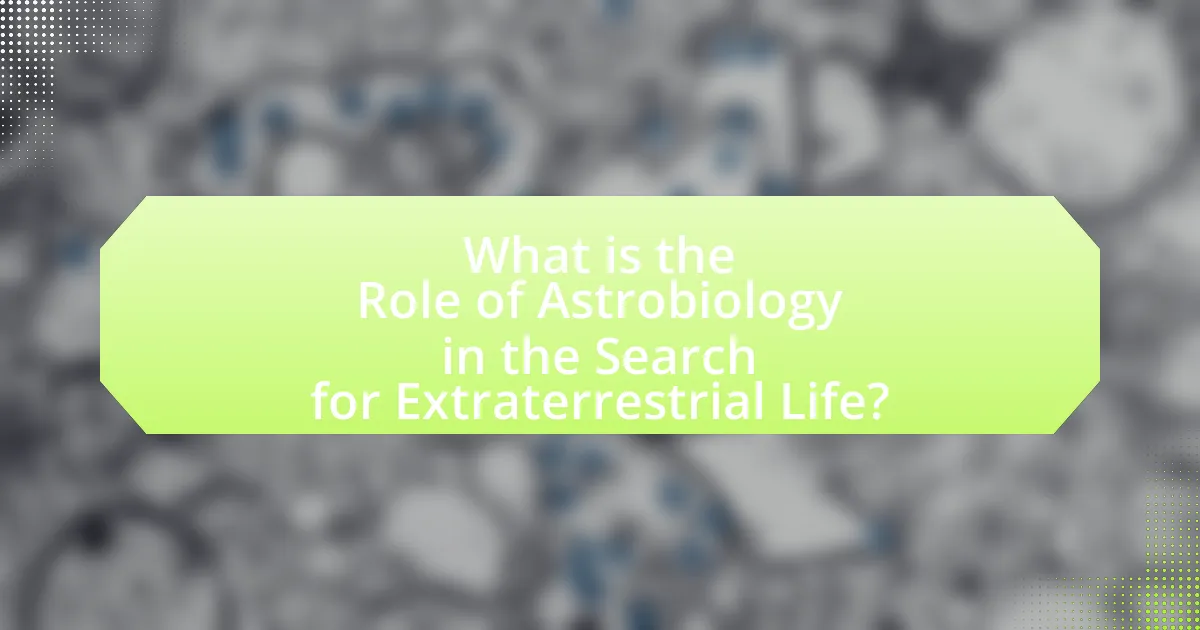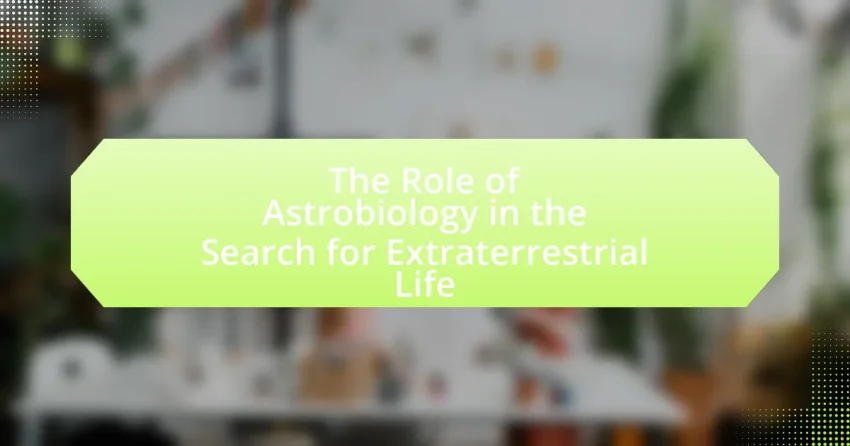Astrobiology is a multidisciplinary field that investigates the potential for life beyond Earth by integrating biology, chemistry, geology, and astronomy. This article explores the role of astrobiology in the search for extraterrestrial life, detailing how scientists define extraterrestrial life, the criteria used to identify potential habitats, and the significance of studying extremophiles. It also examines the methods employed in astrobiological research, including the use of telescopes and the analysis of exoplanets, while addressing the challenges and ethical considerations faced in this pursuit. Additionally, the article highlights the implications of astrobiological discoveries for humanity and the importance of collaboration and interdisciplinary approaches in advancing our understanding of life in the universe.

What is the Role of Astrobiology in the Search for Extraterrestrial Life?
Astrobiology plays a crucial role in the search for extraterrestrial life by studying the potential for life in various environments beyond Earth. This interdisciplinary field combines biology, chemistry, geology, and astronomy to understand the conditions that support life and to identify biosignatures, which are indicators of life. For instance, missions to Mars and the icy moons of Jupiter and Saturn focus on analyzing soil and ice samples for organic compounds and microbial life, demonstrating astrobiology’s practical application in space exploration. Furthermore, astrobiologists utilize models of extreme environments on Earth, such as hydrothermal vents and acidic lakes, to predict where life might exist elsewhere in the universe, thereby guiding the search for habitable exoplanets.
How does astrobiology define extraterrestrial life?
Astrobiology defines extraterrestrial life as any form of life that originates outside of Earth, encompassing a wide range of biological entities, from simple microorganisms to complex multicellular organisms. This definition is grounded in the understanding that life can exist in various environments, potentially differing significantly from those on Earth, as suggested by the discovery of extremophiles—organisms that thrive in extreme conditions on our planet. Astrobiologists study the conditions necessary for life, such as the presence of liquid water, organic molecules, and energy sources, to identify potential habitats for extraterrestrial life within our solar system and beyond, including Mars, Europa, and exoplanets.
What criteria do scientists use to identify potential extraterrestrial life?
Scientists use several criteria to identify potential extraterrestrial life, primarily focusing on the presence of liquid water, organic molecules, and suitable energy sources. Liquid water is essential because it is a solvent for biochemical reactions; for instance, Earth-based life relies on water for survival. Organic molecules, which contain carbon and are fundamental to life as we know it, have been detected in various celestial bodies, including comets and moons like Europa and Enceladus. Additionally, scientists assess energy sources, such as sunlight or chemical energy, which are necessary for sustaining life processes. These criteria are supported by findings from missions like the Mars rovers and the study of exoplanets, where conditions similar to those on Earth have been identified, indicating the potential for life.
How does the study of extremophiles inform our understanding of life beyond Earth?
The study of extremophiles enhances our understanding of life beyond Earth by demonstrating that life can thrive in extreme conditions previously thought to be inhospitable. Extremophiles, such as thermophiles and halophiles, have been found in environments like hydrothermal vents and salt flats, indicating that life may exist in similar extreme environments on other planets or moons, such as Europa or Enceladus. Research published in the journal “Astrobiology” by authors including Charles Cockell and others highlights that the biochemical adaptations of extremophiles provide insights into the potential for life in extraterrestrial environments, suggesting that life could be more resilient and diverse than previously assumed.
Why is astrobiology important in the search for extraterrestrial life?
Astrobiology is important in the search for extraterrestrial life because it combines biology, chemistry, and planetary science to understand the potential for life beyond Earth. This interdisciplinary field investigates the conditions necessary for life, such as water, energy sources, and suitable environments, which are critical for identifying habitable exoplanets. For instance, the discovery of extremophiles—organisms that thrive in extreme conditions on Earth—expands the understanding of where life might exist elsewhere in the universe, suggesting that life could survive in environments previously thought to be inhospitable. Additionally, astrobiology informs the design of missions to other planets and moons, such as Mars and Europa, by guiding the search for biosignatures and the development of instruments capable of detecting signs of life.
What insights does astrobiology provide about the origins of life?
Astrobiology provides insights into the origins of life by exploring the conditions and chemical processes that could lead to life beyond Earth. Research indicates that life may arise from simple organic compounds through processes such as abiogenesis, where environmental factors like temperature, pH, and the presence of water facilitate chemical reactions. For instance, studies of extremophiles—organisms that thrive in extreme environments—suggest that life can emerge in diverse conditions, expanding the potential habitats for life in the universe. Additionally, the discovery of amino acids and other organic molecules in space, such as those found in meteorites, supports the idea that the building blocks of life are widespread in the cosmos, indicating that life’s origins may not be unique to Earth.
How does astrobiology influence the design of space missions?
Astrobiology significantly influences the design of space missions by guiding the selection of targets, instruments, and methodologies aimed at detecting signs of life beyond Earth. For instance, missions to Mars, such as the Perseverance rover, are equipped with instruments specifically designed to analyze soil and rock samples for biosignatures, reflecting astrobiological principles that prioritize environments where life could exist. Additionally, astrobiology informs the development of life detection technologies, such as spectroscopy and sample return systems, which are crucial for analyzing extraterrestrial materials. This focus on potential habitability and biosignature detection is evident in NASA’s Astrobiology Strategy, which emphasizes the importance of understanding the conditions that support life in the universe.

What methods do astrobiologists use to search for extraterrestrial life?
Astrobiologists use a variety of methods to search for extraterrestrial life, including the study of extreme environments on Earth, the analysis of planetary atmospheres, and the exploration of celestial bodies. By examining extremophiles—organisms that thrive in harsh conditions—scientists gain insights into potential life forms that could exist on other planets. Additionally, astrobiologists utilize spectroscopy to analyze the atmospheres of exoplanets for biosignatures, such as oxygen and methane, which may indicate biological activity. Missions to Mars and the icy moons of Jupiter and Saturn involve robotic exploration to search for signs of life or habitable conditions. These methods are supported by findings from missions like the Mars Rover and the Kepler Space Telescope, which have provided critical data on the potential for life beyond Earth.
How do telescopes contribute to the search for extraterrestrial life?
Telescopes significantly contribute to the search for extraterrestrial life by enabling the observation of distant planets and celestial bodies for signs of habitability and biosignatures. Advanced telescopes, such as the Kepler Space Telescope, have discovered thousands of exoplanets in the habitable zone of their stars, where conditions may support life. Additionally, telescopes equipped with spectrometers analyze the atmospheres of these exoplanets for chemical signatures indicative of life, such as oxygen, methane, and water vapor. For instance, the James Webb Space Telescope is designed to study the atmospheres of exoplanets in unprecedented detail, enhancing our understanding of their potential to harbor life.
What role do exoplanet studies play in astrobiology?
Exoplanet studies are crucial in astrobiology as they help identify potentially habitable environments beyond Earth. By analyzing the atmospheres, compositions, and orbits of exoplanets, scientists can assess their suitability for life. For instance, the discovery of exoplanets in the habitable zone, where conditions may allow for liquid water, directly informs the search for extraterrestrial life. Research has shown that over 4,000 exoplanets have been confirmed, with many located in their star’s habitable zone, indicating a significant potential for life-supporting conditions. This data is essential for guiding future missions and observational strategies aimed at detecting biosignatures, or signs of life, on these distant worlds.
How are biosignatures detected in distant atmospheres?
Biosignatures in distant atmospheres are detected primarily through spectroscopy, which analyzes the light spectrum emitted or absorbed by a planet’s atmosphere. This method allows scientists to identify specific chemical signatures associated with biological processes, such as oxygen, methane, and water vapor. For instance, the James Webb Space Telescope utilizes near-infrared spectroscopy to examine the atmospheres of exoplanets, revealing potential biosignatures by detecting the unique absorption lines of these gases. Studies have shown that the simultaneous presence of oxygen and methane is a strong indicator of biological activity, as these gases tend to react with each other and would not coexist in significant quantities without ongoing replenishment from biological sources.
What are the implications of astrobiological research for humanity?
Astrobiological research has significant implications for humanity, primarily by enhancing our understanding of life’s potential beyond Earth and informing our search for extraterrestrial life. This research expands our knowledge of the conditions necessary for life, which can lead to advancements in biotechnology and environmental sustainability on Earth. For instance, studies of extremophiles—organisms that thrive in extreme conditions—have provided insights into potential life forms on other planets and have applications in developing resilient agricultural practices. Furthermore, the discovery of exoplanets in habitable zones, as reported by NASA’s Kepler mission, suggests that life could exist elsewhere, prompting philosophical and ethical discussions about humanity’s place in the universe. These findings can influence space exploration policies and funding, as well as inspire future generations in science and technology fields.
How might the discovery of extraterrestrial life impact society?
The discovery of extraterrestrial life would profoundly impact society by altering humanity’s understanding of its place in the universe. This shift could lead to significant changes in philosophical, religious, and scientific perspectives, as people grapple with the implications of not being alone in the cosmos. Historical precedents, such as the Copernican Revolution, illustrate how paradigm shifts in understanding our position in the universe can lead to widespread societal transformation. Additionally, the discovery could spur advancements in technology and international collaboration, as nations unite in the pursuit of knowledge about extraterrestrial beings and their environments.
What ethical considerations arise from astrobiological studies?
Astrobiological studies raise several ethical considerations, primarily concerning planetary protection, the potential for contamination, and the implications of discovering extraterrestrial life. Planetary protection involves ensuring that missions to other celestial bodies do not contaminate those environments with Earth organisms, which could disrupt native ecosystems or compromise scientific integrity. The potential for contamination also extends to Earth, where the introduction of extraterrestrial organisms could pose unforeseen risks to terrestrial life. Furthermore, the discovery of extraterrestrial life raises profound ethical questions about the rights of such life forms, their treatment, and the responsibilities of humanity in interacting with them. These considerations highlight the need for ethical frameworks to guide astrobiological research and exploration.

What challenges does astrobiology face in its research?
Astrobiology faces several significant challenges in its research, primarily due to the complexity of life and the vastness of the universe. One major challenge is the difficulty in defining what constitutes life, as it may exist in forms vastly different from those on Earth. Additionally, the search for extraterrestrial environments that could support life is hindered by the limitations of current technology, which restricts our ability to explore distant planets and moons. For instance, missions to Mars and the icy moons of Jupiter and Saturn are costly and time-consuming, often requiring years of planning and execution. Furthermore, the interpretation of data collected from these missions can be ambiguous, making it challenging to draw definitive conclusions about the presence of life. These factors collectively complicate the pursuit of understanding life’s potential beyond Earth.
What are the limitations of current astrobiological techniques?
Current astrobiological techniques face several limitations, primarily related to the challenges of detecting biosignatures and the constraints of existing technology. For instance, many techniques rely on remote sensing, which can struggle to differentiate between biological and abiotic signals, leading to potential false positives. Additionally, the limited resolution of telescopes and instruments restricts the ability to analyze distant exoplanets in detail, making it difficult to confirm the presence of life. Furthermore, current laboratory simulations of extraterrestrial environments often fail to replicate the complexity of real-world conditions, limiting the understanding of how life might arise and survive elsewhere. These limitations highlight the need for advancements in technology and methodology to enhance the search for extraterrestrial life.
How do technological constraints affect the search for extraterrestrial life?
Technological constraints significantly limit the search for extraterrestrial life by restricting the capabilities of detection and analysis tools. For instance, current telescopes can only observe a fraction of the universe, and their sensitivity is limited, making it challenging to identify distant exoplanets or analyze their atmospheres for biosignatures. The Kepler Space Telescope, which discovered over 2,600 exoplanets, operated within the constraints of its technology, focusing on a small patch of sky and relying on the transit method, which can miss planets that do not pass directly in front of their stars. Additionally, the lack of advanced propulsion systems restricts our ability to send probes to potentially habitable moons or planets within our solar system, such as Europa or Enceladus, where signs of life may exist beneath icy surfaces. These technological limitations hinder the comprehensive exploration necessary to confirm or deny the existence of extraterrestrial life.
What are the scientific uncertainties in astrobiology?
Scientific uncertainties in astrobiology include the unknown conditions necessary for life to arise, the diversity of potential life forms, and the limitations of current detection methods for extraterrestrial life. For instance, while Earth-based life thrives in a variety of extreme environments, it remains unclear whether similar conditions elsewhere in the universe can support life. Additionally, the potential for life to exist in forms vastly different from terrestrial organisms complicates the search, as current detection techniques are primarily designed to identify Earth-like biosignatures. Furthermore, the vastness of space and the limitations of technology hinder our ability to explore and analyze distant celestial bodies effectively, leading to uncertainties in our understanding of where and how to search for life beyond Earth.
How can collaboration enhance astrobiological research?
Collaboration can enhance astrobiological research by pooling diverse expertise and resources, leading to more comprehensive investigations. For instance, interdisciplinary teams combining astrophysics, biology, and geology can tackle complex questions about life in extreme environments, which is crucial for understanding potential extraterrestrial habitats. Collaborative projects, such as the Mars Exploration Program, demonstrate that shared knowledge and technology accelerate discoveries, as seen in the identification of microbial life indicators on Mars. Furthermore, partnerships between academic institutions and space agencies facilitate access to advanced instruments and funding, thereby expanding the scope and impact of astrobiological studies.
What role do international partnerships play in astrobiology?
International partnerships are crucial in astrobiology as they facilitate collaborative research, resource sharing, and the pooling of expertise across nations. These partnerships enable access to diverse scientific knowledge and technologies, enhancing the ability to conduct complex missions, such as Mars exploration and the study of extremophiles on Earth. For instance, the collaboration between NASA and the European Space Agency on the Mars Sample Return mission exemplifies how joint efforts can lead to more comprehensive scientific outcomes. Additionally, international partnerships often lead to shared funding opportunities, which can significantly increase the scale and scope of astrobiological research initiatives.
How can interdisciplinary approaches improve our understanding of extraterrestrial life?
Interdisciplinary approaches can significantly enhance our understanding of extraterrestrial life by integrating knowledge from various scientific fields such as biology, chemistry, astronomy, and geology. This integration allows for a comprehensive analysis of the conditions necessary for life, the biochemical processes that sustain it, and the potential environments where life could exist beyond Earth. For instance, astrobiologists utilize data from planetary science to identify exoplanets within habitable zones, while biochemists study extremophiles on Earth to understand the limits of life. Research published in “Astrobiology” by authors like Sara Seager emphasizes that combining insights from these disciplines leads to more robust models of life’s potential forms and habitats in the universe.
What practical steps can individuals take to engage with astrobiology?
Individuals can engage with astrobiology by pursuing education in relevant scientific fields such as biology, chemistry, and astronomy. Enrolling in university courses or online programs focused on astrobiology or related disciplines provides foundational knowledge and skills. Participating in citizen science projects, such as those offered by NASA or other research institutions, allows individuals to contribute to ongoing astrobiological research. Attending conferences, workshops, and public lectures on astrobiology fosters networking opportunities and keeps individuals informed about the latest discoveries and theories. Additionally, reading scientific literature and popular science books on astrobiology enhances understanding and stimulates interest in the field.
How can education and outreach promote interest in astrobiology?
Education and outreach can promote interest in astrobiology by providing accessible information and engaging experiences that highlight the significance of the field. Programs such as public lectures, workshops, and interactive exhibits can demystify complex concepts and showcase the latest discoveries in astrobiology, making the subject more relatable. For instance, initiatives like NASA’s Astrobiology Program have successfully engaged the public through educational resources and citizen science projects, leading to increased awareness and enthusiasm for the search for extraterrestrial life. These efforts not only inform but also inspire curiosity and critical thinking, fostering a new generation of scientists and enthusiasts in astrobiology.
What resources are available for those interested in astrobiology?
Numerous resources are available for those interested in astrobiology, including academic journals, online courses, and research institutions. Academic journals such as “Astrobiology” and “International Journal of Astrobiology” publish peer-reviewed research and reviews in the field. Online platforms like Coursera and edX offer courses on astrobiology, often created by leading universities. Research institutions such as NASA’s Astrobiology Institute and the European Space Agency provide access to research findings, data, and educational materials. These resources collectively support the study and exploration of astrobiology, facilitating knowledge acquisition and research opportunities.
